| | |
Template:Lightsaber form infobox
- "It is simple, and its simplicity is strength."
- ―Kreia
Form I: Shii-Cho, also known as The Way of the Sarlacc or The Determination Form, was the first of the seven forms of lightsaber combat. This combat form was developed during the transitional period within the Jedi Order from ancient metal swords to more contemporary lightsabers. Shii-Cho was intended to cater to these new weapons, establishing the basic motions and target zones utilized with a lightsaber. As Shii-Cho was effectively an experimental combat form, and was created prior to the emergence of Dark Jedi and Sith Lords, it did not address the issue of lightsaber-to-lightsaber combat, and was quickly replaced by Form II: Makashi. Despite this, Shii-Cho continued to find a niche as a training form, with almost every Jedi duelist receiving some instruction in it, and including elements in their own combat styles. Shii-Cho was considered an effective fall-back option when no other form or combat style would do.
In combat, Form I lightsaber combat was wild and raw, relying on deliberate tactics and being primarily aimed towards disarming rather than injuring foes, in keeping with Jedi philosophy. Basic initiates in the style demonstrated rather clumsy performance, though in the hands of a master, Shii-Cho was fluid but highly randomized and unpredictable.
History
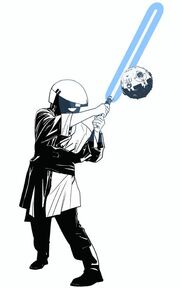
Historically, Shii-Cho was often applied as a tutorial form.
Original lightsabers were unstable and cumbersome weapons, used merely for ceremonial purposes, and requiring no specialized fighting methods for such usage. However, as lightsaber technology developed and they became usable in combat, a combat form tailored to make use of the advantages offered by lightsabers and compensate for their weaknesses became needed. Thus, the first form of lightsaber combat was developed.[1]
As the most ancient style of lightsaber combat, Shii-Cho was developed during the transition period from swords to lightsabers. Lightsabers were wielded in a manner similar to swords, so many of the maneuvers, such as attacks or parries, remained unchanged, as the key principles of the old sword-fighting methods continued to be incorporated. The simplicity and persistent methods of the form led it to being dubbed the "Way of the Sarlacc" and the "Determination Form".[1]
As Shii-Cho was developed prior to either the emergence of Dark Jedi or Sith Lords, it was not created with lightsaber-to-lightsaber combat in mind. Despite this, it was the preferred form of such groups when they began appearing, as it was quite simply the only option. As lightsaber duels between practitioners of the Force became increasingly common, Form I was judged as being inadequate for the task, leading to the development of the second form of lightsaber combat; Makashi.[1]
Despite the development of a combat form tailored to lightsaber dueling, Shii-Cho was not rendered obsolete. Its simplicity and basic focuses left the form ideally suited for basic training, and it was used to provide initiates with an early introduction to lightsaber combat. Shii-Cho remained an effective form of combat for thousands of years, its simplicity making it a good fallback option when no other form would do.[2] However, a true master of the form could use it in both lightsaber combat and battlefield situations to great effect, as demonstrated by Kit Fisto on numerous occasions.
Description
- Kit Fisto: "I should have gone closer to the edge. Released myself into the Force, become more unpredictable. More random."
- Obi-Wan Kenobi: "That would have been dangerous. Not to your body, perhaps, but to your spirit."
- Kit Fisto: "It is the way of Form I."
- ―Kit Fisto and Obi-Wan Kenobi discuss Shii-Cho[src]
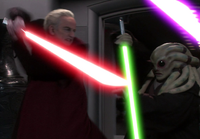
Kit Fisto uses Shii-Cho against Darth Sidious.
As Shii-Cho was an extension of traditional sword-fighting styles, it retained the basics of attacks, parries, and body zones established by such ancient methods.[1] Shii-Cho fostered an emotionally-heated mindset, which resulted in the considerable temptation to execute combat with lethal intent, requiring great restraint to exercise the form without going too far. Despite the pull to kill, the style was designed for the purpose of disarming without seriously injuring.[3][4]
Shii-Cho swordplay was simplistic and raw. In the hands of a master, the bladework was described as "like watching water flow over the falls."[5] However, less adept practitioners displayed much more basic and somewhat clumsy performance. In combat, Form I encouraged deliberate tactics, calling for continuous, step-by-step advancement while cutting off the opponent's angles.[6]
Shii-Cho was specialized towards engaging multiple opponents, the wide, sweeping motions being ideally suited towards attacking numerous adversaries. However, Form I was not as useful against single opponents, as such enemies had complete mobility and could find a weakness in Shii-Cho's comparatively clumsy bladework.[2]
Training and practice
- "Form I, also called Shii-Cho, requires little explanation, as every Jedi youngling learns the basics of attack, parry, body target zones, and practice drills called velocities."
- ―Cin Drallig
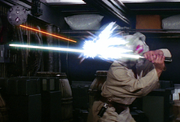
Luke Skywalker engaging in early Shii-Cho blast-deflect training with a remote
As the most simplistic form, Shii-Cho was the first form taught to initiates within the Jedi Order. Form I training provided the basic knowledge of the sword-fighting principles and blast-deflection skill that was required for practice of all the other forms.[4]
In order to teach students to draw upon the Force rather than rely on their senses, early level Shii-Cho blast-deflect training was conducted with a blindfold, forcing the initiate to rely upon his instincts.[7] Later training was conducted through the use of sequences and velocities, the continuous repetition making the moves instinctive reflexes. These training regimens were carried over to all following lightsaber combat forms, which used similar methods.[4][8]
Known moves and maneuvers
Shii-Cho body target zones
- "Form I was created by the ancient Jedi during the transition from metal swords to energy beam lightsabers, and the principles of blade contact remain essentially the same."
- ―Cin Drallig
The basic rules of attacks, parries and body target zones were established by Shii-Cho combat. Shii-Cho also had two methods of combat which determined how these moves were executed; Ideal Form and Live Combat Form.[9]
Ideal Form 1 was mainly used in sparring, and all the moves and maneuvers were executed at perfect horizontal/vertical angles, with attacks and parries being perpendicular to one another. The Live Combat Form was much more functional, the attacks being diagonal strikes at each respective body zone, the goal being to increase speed and reduce actual movement.[9]
The body target zones were numbered as follows; 1 - head, 2 - right arm and side, 3 - left arm and side, 4 - back, 5 - right leg, 6 - left leg.[9]
Shii-Cho philosophy emphasized victory without injury and as such, the sun djem mark of contact was traditionally employed by Form I practitioners. Keeping with the use of sun djem, one of the attacks utilized by Form I practitioners was referred to as the "Disarming Slash", consisting of a strike directed at the opponent's weapon in an attempt to rip it out of their grasp.[10] Another of the techniques utilized by Shii-Cho was dubbed the "Sarlacc Sweep", a wide sweeping attack in which the duelist struck against multiple enemies.[10] Other maneuvers included the basic Form I horizontal slash.[11]
Applications
- "Because the ancient Jedi did not have lightsaber-wielding enemies, Form I does not address the lightsaber-to-lightsaber combat."
- ―Cin Drallig
Lucien Draay demonstrated the "disarming slash" while sparring with Raana Tey and Xamar.
Among the skilled warriors who utilized Shii-Cho in combat were Lucien Draay[12] and Meetra Surik.[2] Draay was trained by the failed Jedi Haazen, who took over due to the neglectful behavior of Lucien's mother, Krynda. Despite Haazen's lack of power or skill, he was able to mold Lucien into a formidable duelist, proven when Lucien took on the four Seers Raana Tey, Feln, Xamar, and Q'Anilia simultaneously in a group sparring match and beat them all. However, Draay was not invincible, as shown during his final confrontation with his former pupil, Zayne Carrick, whom Draay tried to kill after falling under Haazen's influence when the latter's identity as a Sith Acolyte was revealed. Despite Carrick's comparative lack of skill, and his self-described "awkward" relationship with the Force, he was able to match Lucien blow for blow and hold him off. However, Lucien's skill was still enough that Carrick could not defeat him, and Carrick only survived because he managed to convince Lucien to back down.[13]
As for Surik, she received training in Shii-Cho during her time in the Jedi Order. However, after she left the Order in the aftermath of the Mandalorian Wars, she cut herself off from the Force and accordingly "forgot" all her knowledge regarding it, including her skill in Shii-Cho. As she began reawakening to it, she instinctively regained her skills with Form I. Her application of the style was highly versatile, applied with numerous weapons. She used the form in a manner that allowed her to fare well against multiple opponents, but not to detract from her ability to deal with a single adversary.[2]
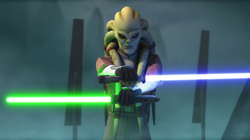
Kit Fisto was capable of applying Shii-Cho to fighting with dual-blades.
A Form I specialist who lived during the Clone Wars was Kit Fisto, who was credited as one of the best duelists in the Jedi Order. His mastery of the form was advanced, and he applied it in many battles and duels, always with his trademark smile. He went head to head with many of the most dangerous adversaries of the Clone Wars and survived. A notable opponent was General Grievous, whom Fisto proved able to hold his own against and nearly defeat,[14] as Form I's specialization against multiple foes[4] was well-suited to holding off the four lightsabers Grievous' bizarre mechanical anatomy allowed him to wield. Fisto's quick thinking and speedy reflexes enabled him to recognize vulnerable body zones on his opponents and react immediately, as shown when he cut off Grievous' legs and later one of his hands during their duels.[14] His versatility with Shii-Cho was such that he could ably apply it towards the usage of dual-blades, or even lightwhips.[3]
However, Kit Fisto was not without his weaknesses. Form I was ideal when heavily outnumbered and effective against many opponents, but a single opponent was able to find flaw in it, and this proved to be Kit Fisto's downfall.[4] Against Asajj Ventress on Ord Cestus, he simply wasn't quick enough with his blade to deal with the Makashi specialist, and Shii-Cho was considered weak against Form II in any case.[3][15][4] His final battle against Darth Sidious ended with Fisto's death, as—despite Fisto's own power and skill—he simply wasn't able to compete with Sidious. However, Fisto managed to last longer than his fellow combatants, Agen Kolar and Saesee Tiin, being able to block several of Sidious' vicious blows before falling.[16]
Obi-Wan Kenobi commented Form I was wild, raw, and deadly, requiring much emotional heat, and Kit Fisto noted how hard it was to control the pull of Form I, disabling opponents rather than killing them.[3] However, Kenobi sometimes did infuse elements of Shii-Cho into his swordplay, including the rematch with Count Dooku onboard the Invisible Hand. Dooku himself described Shii-Cho swordplay as "deliberate as a lumberdroid, moving step by step, cutting off the angles, clumsy but relentlessly dogged."[6]
Notable practitioners
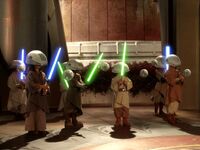
Jedi Initiates undergoing early lightsaber training in Shii-Cho
As Shii-Cho had been in existence for millennia, and was used to provide early training in lightsaber combat, almost all lightsaber duelists received some level of training in it and included aspects of the form in their own fighting methods.
Other than Lucien Draay,[12] Meetra Surik,[2] Obi-Wan Kenobi,[6] and Kit Fisto,[3] Shii-Cho had many advanced and/or specialist practitioners. In more recent years, the form was mastered by the Jedi swordmaster Cin Drallig, along with the next six forms.[17] Master Kirlocca of the Almas Academy was also credited as having mastered Form I.[5] Kento Marek was a Shii-Cho practitioner, and his son, Galen Marek, also known as Starkiller, maintained a familiarity with the form, able to recognize it in his opponent's technique.[18]
Dooku himself trained General Grievous and his IG-100 MagnaGuards in the style.[19] Darth Vader incorporated elements of Shii-Cho into his personal variant of Form V, and his son, Luke Skywalker, received instruction in basic Form I velocities during his early training under Obi-Wan Kenobi.[11]
Shii-Cho, like the other six forms, would eventually be rediscovered by the New Jedi Order.[20]
Behind the scenes
Shii-Cho was first described in the Fightsaber: Jedi Lightsaber Combat article in Star Wars Insider 62, written by David West Reynolds and fencer Jack "Stelen" Bobo, identified it as Form I lightsaber combat. The proper name of the form, "Shii-Cho", as well as its alternate titles as the "Determination Form" and the "Way of the Sarlacc" would be specified in later sources.[21][22]
While every Jedi-trained duelist would have received training in Form I, there are few specialist practitioners. However, there are some individuals theorized to be adherents, Sora Bulq, based on statements in the official Databank, which credits him as a master of all known lightsaber forms, though Shii-Cho isn't explicitly mentioned.
Shii-Cho, along with the other lightsaber forms, appears in Star Wars Galaxies as part of moves and techniques employable by Jedi characters. This has not definitively been clarified to be canonical. [23]
Appearances
- Star Wars: Knights of the Old Republic II: The Sith Lords
- Star Wars: The Old Republic
- Star Wars Episode II: Attack of the Clones (First appearance)
- Jedi: Aayla Secura
- The Cestus Deception
- Star Wars: Clone Wars
- Star Wars: Battlefront II
- Star Wars: Republic: Show of Force
- Star Wars: Obsession
- Labyrinth of Evil
- Star Wars Episode III: Revenge of the Sith
- Star Wars Episode III: Revenge of the Sith novel
- Coruscant Nights III: Patterns of Force
- The Force Unleashed novel
- Rebel Force: Trapped
Sources
 "Fightsaber: Jedi Lightsaber Combat" — Star Wars Insider 62
"Fightsaber: Jedi Lightsaber Combat" — Star Wars Insider 62- Star Wars: Attack of the Clones: The Visual Dictionary
- Hero's Guide
- Knights of the Old Republic II: The Sith Lords: Prima Official Game Guide
- Star Wars: Revenge of the Sith: The Visual Dictionary
 Jedi Abilities: Learning the Way on the official Star Wars Galaxies website (content now obsolete; backup link (players/content.vm?id=66843&resource=features) not verified!)
Jedi Abilities: Learning the Way on the official Star Wars Galaxies website (content now obsolete; backup link (players/content.vm?id=66843&resource=features) not verified!)- Order 66: Destroy All Jedi
- Template:LFC
- Threats of the Galaxy
 Star Wars Galaxies Trading Card Game — [[{{{set}}}]] (Card: Shii-Cho) (backup link)
Star Wars Galaxies Trading Card Game — [[{{{set}}}]] (Card: Shii-Cho) (backup link)- The Complete Star Wars Encyclopedia
- Star Wars: The Clone Wars Comic UK 6.5
- The Jedi Path: A Manual for Students of the Force
 Sora Bulq in the Databank (content now obsolete; backup link)
Sora Bulq in the Databank (content now obsolete; backup link)- Totally 20: The Phantom Menace
- The Essential Guide to Warfare
 Star Wars: The Card Game — FFGTCG
Star Wars: The Card Game — FFGTCG
Notes and references
- ↑ 1.0 1.1 1.2 1.3 Jedi vs. Sith: The Essential Guide to the Force
- ↑ 2.0 2.1 2.2 2.3 2.4 Cite error: Invalid
<ref>tag; no text was provided for refs namedKOTOR2 - ↑ 3.0 3.1 3.2 3.3 3.4 The Cestus Deception
- ↑ 4.0 4.1 4.2 4.3 4.4 4.5 Fightsaber: Jedi Lightsaber Combat
- ↑ 5.0 5.1 Template:LFC
- ↑ 6.0 6.1 6.2 Star Wars Episode III: Revenge of the Sith novel
- ↑ Star Wars Episode IV: A New Hope
- ↑ Darth Bane: Path of Destruction
- ↑ 9.0 9.1 9.2 Star Wars: Attack of the Clones: The Visual Dictionary
- ↑ 10.0 10.1 Jedi Academy Training Manual
- ↑ 11.0 11.1
 Fightsaber: Mastering the Art of Lightsaber Combat on StarWars.com (content now obsolete; backup link)
Fightsaber: Mastering the Art of Lightsaber Combat on StarWars.com (content now obsolete; backup link)
- ↑ 12.0 12.1 Cite error: Invalid
<ref>tag; no text was provided for refs namedKOTORcg - ↑ Star Wars: Knights of the Old Republic comics
- ↑ 14.0 14.1 Lair of Grievous
- ↑ Cloak of Darkness
- ↑ Star Wars Episode III: Revenge of the Sith
- ↑ Order 66: Destroy All Jedi
- ↑ The Force Unleashed novel
- ↑ Labyrinth of Evil
- ↑ Jedi vs. Sith: The Essential Guide to the Force
- ↑ Star Wars: Lightsabers: A Guide to Weapons of the Force
- ↑ The Jedi Path: A Manual for Students of the Force (real-life book)
- ↑ http://starwarsgalaxies.station.sony.com/players/content.vm?id=64186&resource=publish; http://starwarsgalaxies.station.sony.com/en_US/players/content.vm?id=66843&resource=features; http://starwarsgalaxies.station.sony.com/players/guides.vm?id=70002
Warning: This infobox is missing the following parameters: protection, precede, blade type, destroyed, range, hilt material, image, affiliation, owners, hilt model, discovered, blade length, markings, culture, type, creator, succeed, capacity, purpose, design, weight, mods, color, name, model, hilt shape, created, crystal, hilt length
